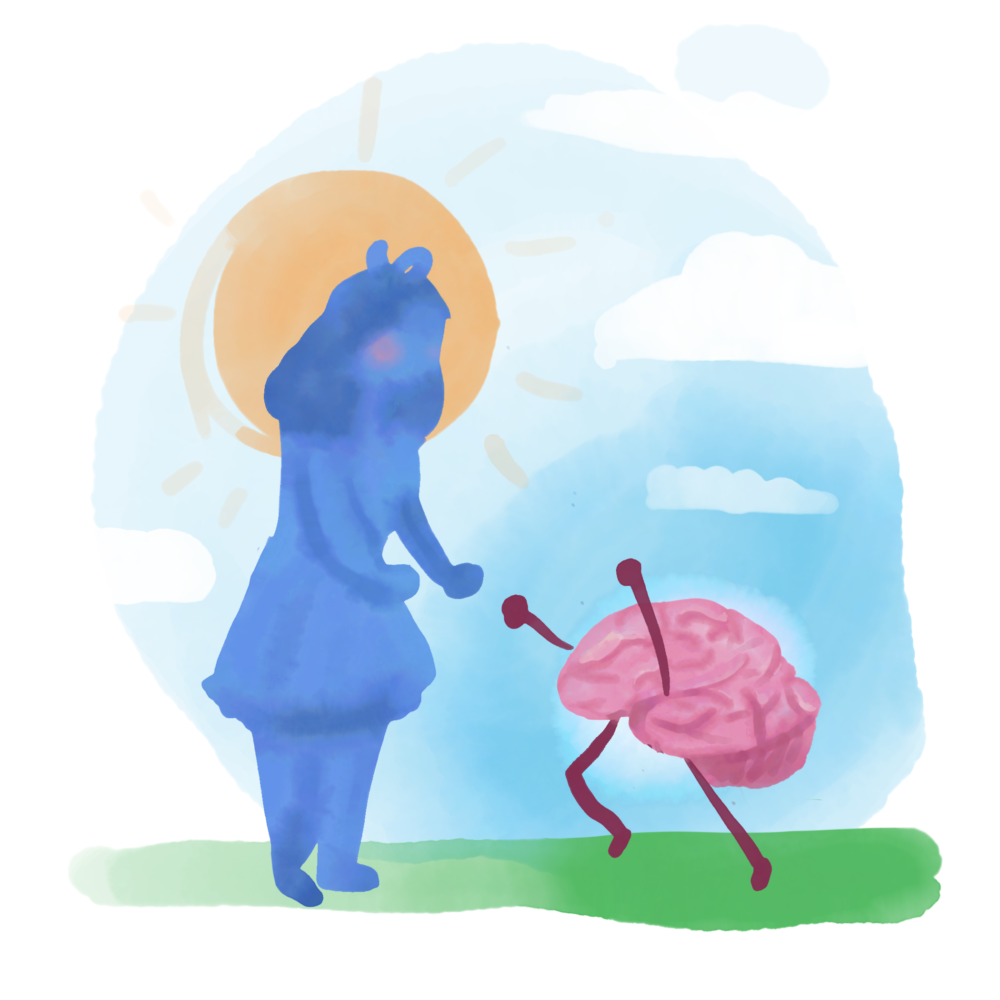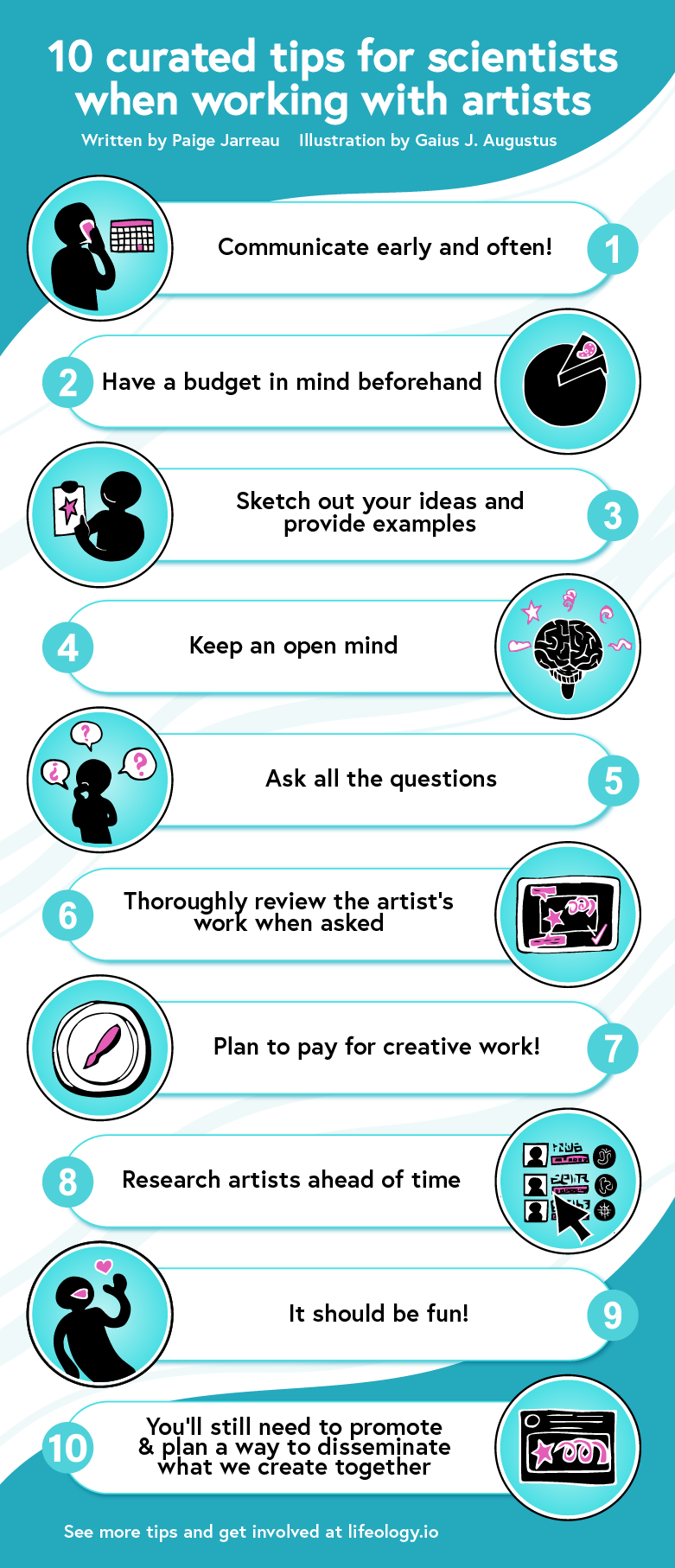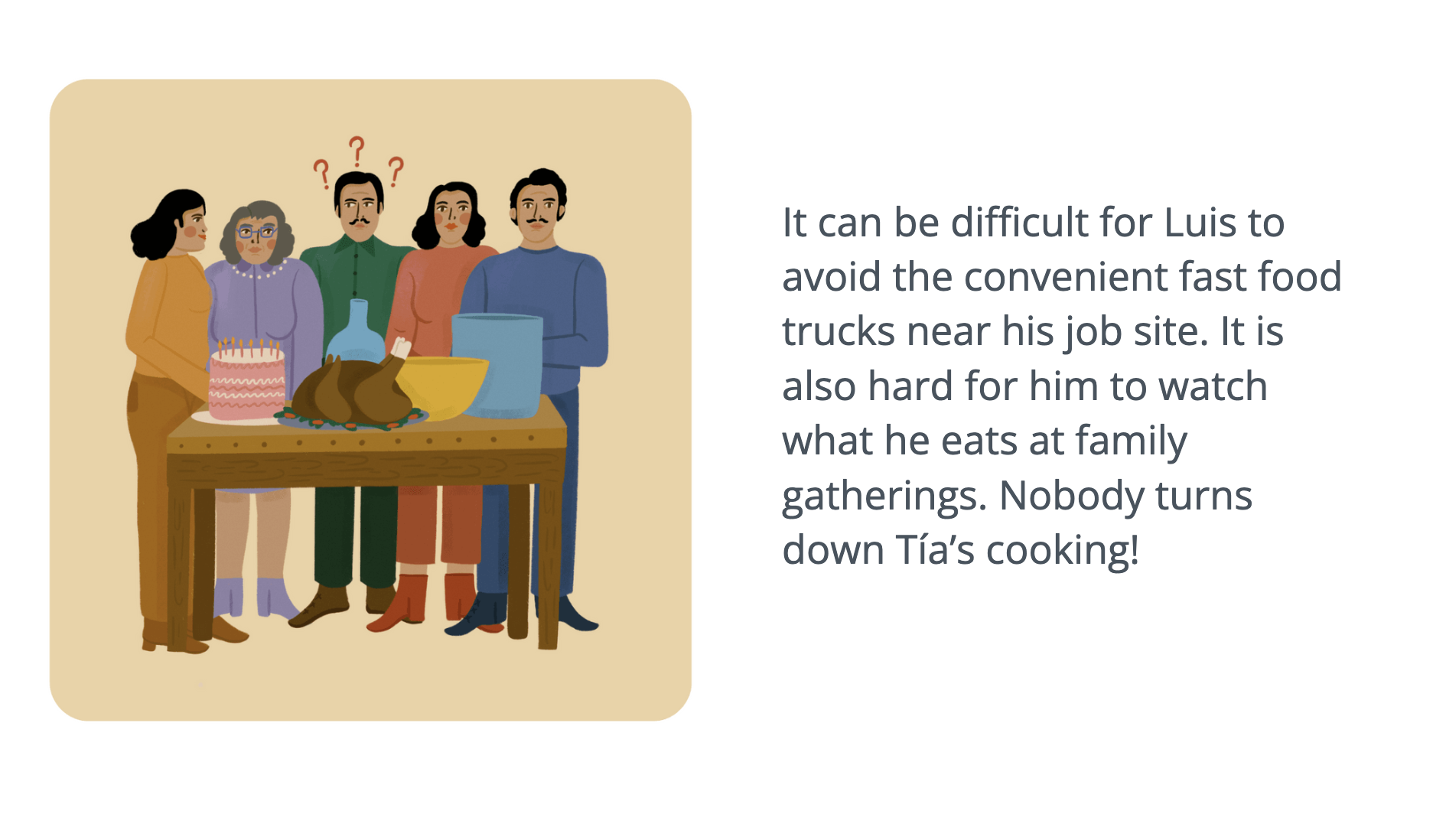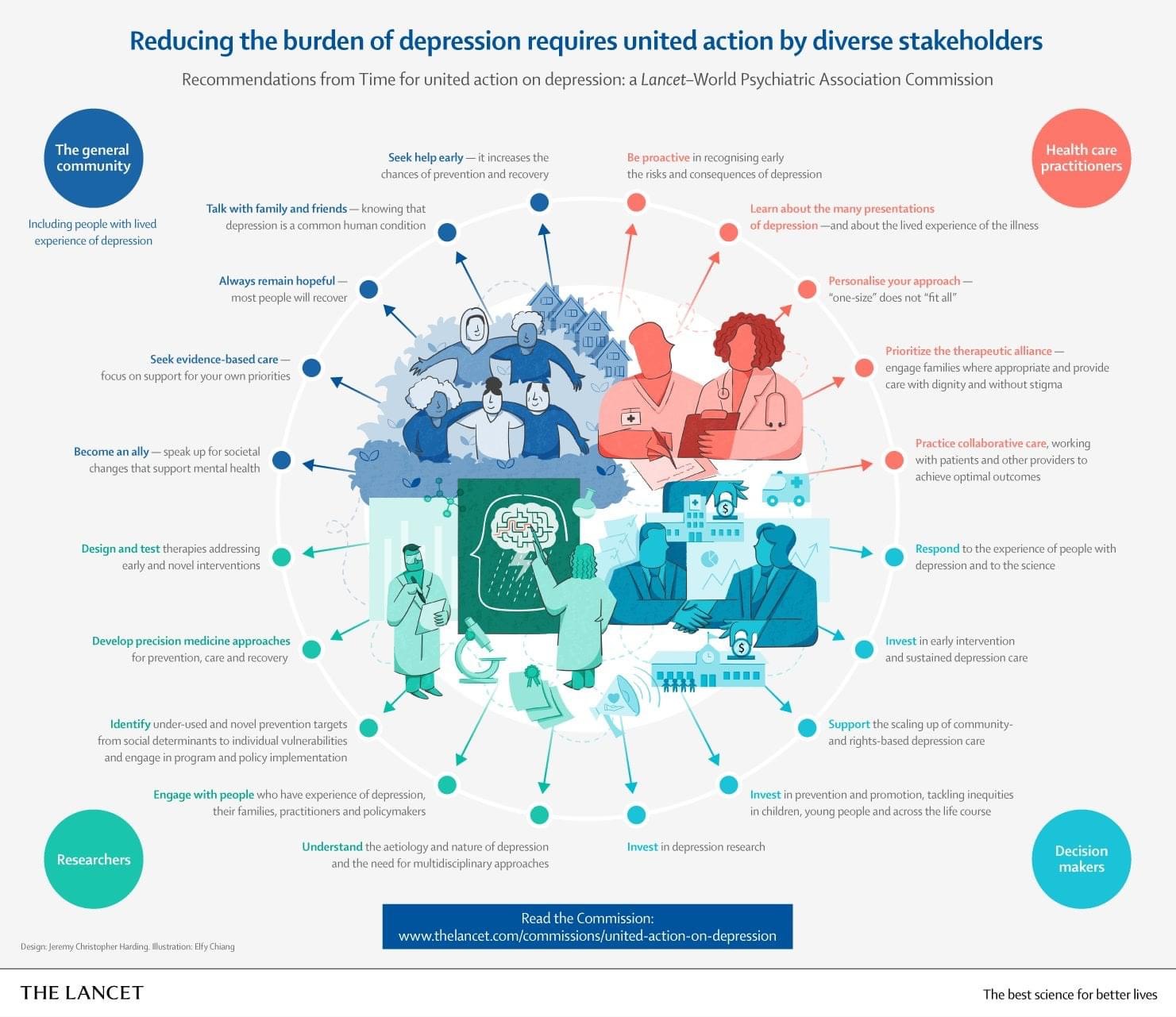Scientists want to work with artists.
When asked, most scientists agree that they are interested in working with artists to boost the impact of their work, from their research papers to their public outreach efforts.
Scientists are interested in getting help with research figures, presentations, graphical abstracts, infographics, illustrations and animations for public education and outreach. Some are also interested in deeper collaborations with artists for public engagement, such as in sci-art galleries and exhibitions, children’s books, games, performances and more. Some go all in and incorporate professional science art into their grant proposals and research processes and materials, with vast potential impact.
But the biggest barrier standing in the way of scientists interested in working with artists is that they don’t know where to start.
I asked 15 sci artists to help answer common questions for scientists about working with artists! Read a curation of their responses below, or download the the full Q&A with them!

What can I expect when working with an artist?
Where can I meet a science artist?
Where do I start – how do I reach out?
What questions should I ask?
More tips! (+ an infographic!)
What can I expect from working with an artist?
Expect to learn from them as much as they learn from you about your work! Scientists who interact with artists often experience changes of perspective on their own work, and they also learn how to communicate their work in a more approachable way.

An illustration by Jessika Raisor, for a Lifeology course on mindfulness
Also expect that the artist or designer won’t be able to (and indeed shouldn’t) incorporate every little detail of your work, scientific message or findings into the visual piece you are creating together. (If they did, it would likely end up being way too complicated for most people to decipher, and even scientists in other fields won’t look at a confusing visual or graphic long before giving up, or watch a long video that goes into excruciating scientific detail.) But in working with the artist, you’ll learn how to better narrow down and visually interpret a key message or finding, with exponentially greater impact and engagement your audiences.
In terms of process, expect to have several conversations with the artist or designer you want to work with before the project is complete, or even before it starts in earnest. There will be a lot of things you’ll need to learn from one other about the project or the visual product you are envisioning. They will help you along the way and you will be able to review their work at many stages – but the earlier you can provide feedback to the work-in-progress, the better!
There are also sci-art projects where the only thing to expect is the unexpected! For example if you invite an artist to have a residency in your lab – perhaps to make a science comic about your work! – you might expect them to watch, learn, go into the field with you, choose topics they are most interested in delving into (and that they know broader audiences will be interested in, too), and come up with stories and visuals independently!
Insights from Artists
Abrian Curington: Since the research has to be explained in order for me to visually translate it, I ask all the questions that an average member of the public would ask, and it gets the researcher thinking from a different perspective.
Gaius Augustus: We will discuss the project, agree on a timeline, deliverable, and price. We’ll dig deep into the project’s needs and create a solid plan that goes from start to finish. The goal here is to clearly define the expectations on both ends at each step along the way.
Molly Patton: Scientists are often surprised about the extent to which design positively influences their work – not just how it looks, but also in other ways; we improve their visual communication, it attracts more opportunities for funding and collaboration, industry engagement and of course more discoveries to be translated into commercialised technologies that make a real difference in people’s lives.
Miriam Rivera: Sometimes scientists attach a lot of importance to theory and don’t want to leave anything out. Participating in the process of creating the comic through the reviews gives them the opportunity to see why they should choose only one part of the information or another, why they should tell it in this way or another, and when they enter into the dynamic they even make very valid and fun contributions, whether they are visual metaphors or dialogues, which can be integrated into the comic. And when they see the acceptance it has among readers and the impact on social media and media, they are very satisfied.
How can I meet a science artist?
There are many ways to meet artists and designers to help you communicate your science! Most commonly, scientists find artists via word of mouth and referrals (from other scientists – especially if the artists are scientists turned artists), at conferences, and through social networks.
This can make it difficult for scientists to know where to start if they aren’t already plugged into online science and creative communities. But asking around for artist referrals is a good place to start! Many science artists and designers give in person and online workshop to increase their visibility to scientists.
There are also a growing number of sci-art platforms and websites where scientists can find artists, including:
- Guild of Natural Science Illustrators (gnsi.org)
- SeaHarmony (seaharmony.org)
- Lifeology! Try our scientist-artist matchmaking experience.
- Art the Science – they facility artist residencies in scientific research laboratories across Canada!
- Science Finds Art
Insight from artists
Kirsten Carlson: Regardless of the communication medium (conferences, online, presentations), if I’m inspired by a scientist’s work (ie. they are getting their work out there), I introduce myself. Sometimes a project blossoms, sometimes not. I still get to let them know what I think they are researching is awesome.
Echo Rivera: I often have people reach out to me who have seen my blog or video. Most of the time, it’s people who I have started to cultivate a relationship with — we have had conversations on Twitter or have chatted through email.
Sofie Shen: I’m lucky to be in Pasadena, so there are tons of opportunities with Caltech and JPL where they have lectures, Astronomy on Tap, and other events where I’m very likely to meet scientists and engineers. I also do volunteer work for the Planetary Society, so I’d say if you have any public outreach opportunities around, there are bound to be some artists there. As well, I follow a lot of people on Twitter, I tag my work and scientists find me through those tags, I’ve even connected with a scientist on Tumblr who found me through my tagged work. Recently I participated in a NASASocial, which was excellent for meeting like minded people as well as being able to connect with the scientists behind the Perseverance rover.
Karen Romano: I’ve gone into the field with scientists to do their public outreach and education, or to work as an artist at sea!
Where do I start – how do I reach out to an artist?
The best way to start is with a conversation! If you find science artwork you like, the creator is probably easily contacted and will be responsive to e-mail or social media inquiries (like on Twitter, Facebook or Instagram). Don’t worry about sending a “cold” e-mail or social media message – they will love to hear from you! After some initial correspondence, they may also ask to have a phone or video call with you to go over the details of you project.
Insight from artists
Kirsten Carlson: Connect and introduce yourself and your project via email, social media, etc. It’s also great to include what specific work of mine inspired the scientist to get in touch and where/how they found out about my work.
Gaius Augustus: Reach out to me via email or social media. It helps if you already have a solid idea of what you want, a budget, and a deadline, but I have worked with scientists who only have one or two of these. It also helps if you have looked over my portfolio, though I have many work-in-progress pieces that I can only show you if you contact me.
Abrian Curington: Email me any time! Contact on social media works as well. I totally understand if you’ve never worked with an artist before, and I can help you figure out what you’ll need to make your ideas come to life. It’s helpful to have a deadline and how you want to use the final product in mind.
Echo Rivera: A good way to initiate the conversation is to send a draft sketch or description of what you’d like created, along with your timeline/deadline and budget range. Or, if you just wanna chat to get to know me, then send me a tweet with a gif!
Sofie Shen: You can also look on art sites like Behance, where excellent designers post their projects. As well, you could look at any design schools that are local to you, or publications that have illustrations, and find artists that way. I would just show that you have a reason that you’ve chosen me and propose what your project is in a paragraph or less. It’s not uncommon to be messaged with a brief summary and then the rest is worked out later or after NDA is signed.
What questions should I ask?
How much will it cost? How long will it take? Who crafts the story? What is the process of creating the sci-art product and how does it work? These are some of the first questions that artists hear from scientists at the start of a project. Most science artists are well-practiced at educating scientists on the business and process sides of the work, as much as they are at creating! But this education can be tricky, because most of the time the answer is: “It depends!”

A storyboarding process. Illustration by Anna Doherty.
Science artists and designers can almost always work with you to figure out what is feasible with the budget you have (as long as you HAVE one) – it just may look different that what you imagined. (Yes, in art and design, you get what you pay for!). There are also many different ways that any given artist could approach a project with you.
So when approaching a science artist or designer about a project, you may want to focus on asking about their interest in the project and their availability based on your timeline, asking for examples of their work, and asking them what is possible with the budget that you have. They are here to help you and they want you to succeed! They can create the best product for you when they know all the details of what you are looking for, when, and within what budget. They may also be able to think of creative visual solutions for your end communication goal that you hadn’t previously considered.
But you can help the collaboration go more smoothly if you do research ahead of time. Talk with artists/designers whose existing work you like and fits your project needs! Write up some basic criteria for the end product you want – your objectives, the communication format (is this for print, an in-person event or presentation, online sharing?); target audience; deadline; how much time you have to be involved.
It’s also awesome to just approach a science artist or designer with an idea and be open to brainstorming together about different ways forward!
Insight from artists
Kirsten Carlton: I also often ask what the budget is up front because then I can tailor details like size, timeline, usage rights, medium to the project. I learned that it’s incredibly helpful to provide a project contract that the scientist and I both sign which includes timeline, deliverables, payment, sketches etc. I believe in long term collaborations (lifetime even) and I usually get involved because I’m passionate about the subject and excited about the science and interpreting it visually.
Gaius Augustus: Clients I work with often feel lost when thinking about how the process works from start to finish. The first thing I typically do is give a brief outline of the process and what is expected from each of us at each milestone. I give this in writing and also go over it through a video chat.
Abrian Curington: Oftentimes, I have to ask leading questions, as the client has no idea what to ask for! Or they think that their concept may not be translatable into a visual medium. I will often ask them: What kind of research they’re doing, what sort of outreach they’re interested in, what the deadline is, then I pitch a few ideas to lead them to what they’d like me to create. Once we have a direction, I propose the price that direction would take.
Melody Serra: I also love when I am given creative flexibility, in other words I know what I am aiming for and what my goal is, but the way I get there and how I choose to express that is something I could figure out alongside the scientist.
Amy Hill: First of all, I want scientists to know that they shouldn’t feel nervous if they don’t know a lot about the art process before approaching artists! I know what relevant questions to ask so we both end up with clear expectations of where the project is headed.
Madison Mayfield: I often wish that scientists would begin the conversation by saying what their budget is or working with the artist to apply for funding. Another massive misconception is the time frame many scientists come to you with. Illustration or figure work seems to often be an afterthought or something to begin near the end of the project and I often have to turn people down because they need something next week and I simply don’t have the time or can’t produce what they want in that time frame. It takes work and proper research to create good work and the artist you’re trying to work with may already have loads of other commissions lined up (if they’re lucky!). Coming to the artist with a budget, a decently formed idea, and a time frame are all very important in starting a relationship together!
Artists’ Tips for Scientists!
Here are artists’ top 10 sci-art project tips for scientists:
1. Communicate early and often! Before you apply for grant funding. before you collect data, before you submit your manuscript – it is never too early to have a conversation with an artist or designer about visual communication of your science.
2. Have a budget in mind before you contact us and tell us upfront. Don’t low-ball it, be 100% honest! – Echo Rivera
3. If you can, sketch out your ideas for the project to share us, and provide examples of what you might be looking for.
4. Keep an open mind. Be prepared for us to propose an alternative way to get your point across or design your idea.
5. Ask all the questions.
6. Thoroughly review the artist’s work when asked. That way we can correct mistakes before moving on to later stages where it is much more difficult to do so. Also, think of yourself as the expert in the scientific field. We can make mistakes and no one wants the final project to contain wrong information. – Miriam Rivera
7. Plan to pay for creative work! Include funding to cover illustrations in your planning and grant writing.
8. Do some research. Look on social media for #sciart, search for artists who do the kind of work that interests you, talk to other scientists who have beautiful publications and ask who they worked with in order to find an artist. Pick an artist whose work you enjoy, rather than picking a random artist and trying to get them to do something out of their expertise. Also, don’t just use whoever pops up on your twitter feed first. – Julie Johnson & Abrian Curington & Madison Mayfield
9. It should be fun!
10. You’ll still need to promote and plan a way to disseminate what we create together. Dedicate some funds for this aspect and talk with experts to help you. (Hi from Lifeology, I help scientists share their work on social media! – Paige Jarreau)






